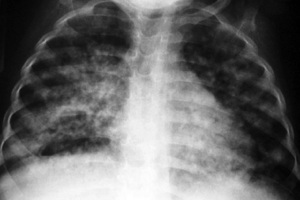Progress towards TB elimination has stalled
Although England continues to be a low incidence country for tuberculosis (TB), decline in rates has levelled off.

TB rates in England remain highest in areas of deprivation and in certain groups living in large urban areas, including vulnerable migrants and people who experience homelessness, contact with the criminal justice system, mental health needs, and/or drug and alcohol misuse.
To mark World TB Day, the UK Health Security Agency (UKHSA) has published its annual TB report, with data up to end of 2021.
Despite an overall downward trend in the number and rate of TB notifications in England during the last 10 years, the rate of decline has slowed in the last 4 years. Unless immediate action is taken, England will fall short of achieving the World Health Organization (WHO)’s End TB Strategy target of 90% reduction in people with TB from 2015 to 2035.
TB is the second leading infectious killer globally, after coronavirus (COVID-19). The WHO estimates that globally 10.6 million people became ill in 2021, a 4.5% increase from 2020.
In 2021, the incidence of TB stood at 7.8 notifications per 100,000 people, compared to 8.4 notifications per 100,000 in 2019. Although this is a decline since before the pandemic, in order to hit the WHO elimination target by 2035, we need to see a reduction in TB rates to 1.05 per 100,000. If we continue at the current rate of decline, we will only hit 5.1 per 100,000 by 2035. Provisional data from 2022 indicates we remain off trajectory.
TB notification rates in England remain highest in large urban areas which are associated with higher levels of deprivation, and in inclusion health groups – a term used to describe people who are socially excluded and typically experience multiple overlapping risk factors for poor health, such as experiencing homelessness or contact with the criminal justice system.
TB disproportionately impacts certain people, in part, due to the barriers they may face in accessing the interventions designed to identify clinical onset of TB; access to diagnostic and treatment services; ability to self-administer treatment and attendance at follow-ups.
Dr Esther Robinson, Head of the TB Unit at UKHSA, said:
Tuberculosis remains a risk to some of the most vulnerable people in our society and this data highlights that progress towards elimination has stalled.
It is vital that we ensure that everyone has access to a timely diagnosis and effective treatment. This will also help us to get on course to eliminating TB in our communities through strengthening the prevention, detection and treatment of active TB in higher risk groups.
Professor Sir Stephen Powis, NHS Medical Director, said:
Since the COVID-19 pandemic there has been a resurgence in infectious diseases, like flu and norovirus, and the latest data shows that rates of tuberculosis have also risen slightly, although they are still lower than they were in 2019.
While the incidence of TB is still considered low by WHO, the NHS, working with UKHSA and other partners, is committed to improving the prevention, detection and control of TB across the country, and anyone with symptoms of the disease should contact their GP or use NHS 111 online to get the appropriate treatment and advice.
Health Minister Maria Caulfield said:
It is vital that we act now to protect the progress that has been made towards eliminating tuberculosis in England over the last decade.
These figures highlight the importance of recognising symptoms early – if you have a persistent cough that has lasted for 3 weeks alongside a fever, contact your GP as soon as possible.
TB is infectious and if not treated can be potentially life threatening. We also know it disproportionately impacts more vulnerable people so it’s important to be vigilant and act so that anyone can access treatment when they need it.
Anyone who has a persistent cough that lasts more than 3 weeks along with a fever should contact their GP surgery.
Symptoms of TB include:
- a persistent cough that lasts more than 3 weeks and usually brings up phlegm, which may be bloody
- breathlessness that gradually gets worse
- lack of appetite and weight loss
- a high temperature
- night sweats
- extreme tiredness or fatigue
People born outside of the UK are disproportionately affected by TB and account for the majority of TB notifications in England at 76.4% in 2021, with rates of TB in this group, at 37.6 per 100,000. This is similar to rates in 2020 at 36.8 per 100,000.
Of people born in the UK, the highest notification rates were in the black-other ethnic group – 19.5 per 100,000 compared with 1.4 per 100,000 for white ethnic group. For non-UK born individuals, notification rates are highest in those who self-report as Indian ethnic group (99.8 per 100,000) and lowest in the white ethnic group (8.9 per 100,000).
Through the joint UKHSA and NHS England (NHSE) TB action plan published in 2021, UKHSA is working to improve the prevention, detection and control of TB in England and to provide partners with the tools to reduce TB incidence in all our communities.
UK Health Security Agency press office
10 South Colonnade
London
E14 4PU
Updates to this page
-
Corrected figure for the reduction in TB rates needed to hit the WHO elimination target.
-
Corrected figure for the reduction in TB rates needed to hit the WHO elimination target.
-
First published.